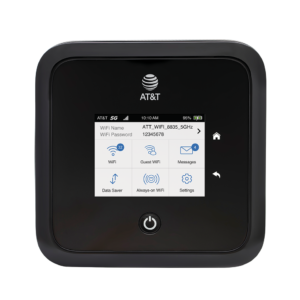Satellite internet has the widest coverage area of any internet option for RVers. You don’t have to worry about being out of cell tower range, no matter where you travel, whether it’s to national or state parks or just outside city limits. You can get a signal wherever you have a clear view of the sky.
As of 2023, one of the only options for portable satellite internet access in an RV is Starlink Roam (once called Starlink RV). Starlink Roam is technically called Starlink Mobile now, because Starlink loves confusing plan names, but we’ll call it Starlink Roam mostly throughout this article for ease of recognition.
While Starlink’s Roam satellite internet is a great option for many RVers, there have been some reports of slowing speeds since the nationwide rollout of the program. Before you make any decisions, you can use Starlink’s availability map to search for specific details on download or upload speeds, location-specific availability, and latency capabilities.
Areas on Starlink’s map that show speeds higher than 25Mbps will be able to support more demanding internet use, such as streaming, video conferencing, and playing online games. If the areas you live in or travel to have speeds of 25Mbps or less, Starlink may only be a good option if you use the internet for things like checking social media, reading articles, and sending emails.
There’s no annual contract on any of Starlink’s Roam plans, only the month-by-month payment that can be paused at any time—a huge pro for those who travel part-time.
If you’ve been wondering about the big cost difference between Starlink’s standard portable hardware ($599) and flat high-performance hardware ($2,500), it lies in when you can use your system. Yes, the standard hardware is quite portable and not that complicated of a setup process, but you have to park to use it, and it has to be set up again every time you relocate.
The flat high-performance hardware, however, is more expensive because it’s designed to be installed directly onto your RV so you can use it in motion. So, shelling out the extra chunk of cash might be worth it for you if you need constant internet access, even while actively traveling. (This setup works great if you’ve got kids chanting to watch their favorite Disney movie while you’re in the middle of driving.)
Starlink Roam’s base plan, Mobile Regional, costs $150 monthly, with a one-time equipment fee of $599 for the standard portable hardware. We recommend this plan if you travel domestically and don’t mind pulling over and setting up your hardware to check your email and Facebook.
The next tier, we recommend mainly to international travelers. It costs $200 per month plus the $599 hardware fee. This plan will suit you if you're a total globe-trotter and often find yourself needing an internet connection on entirely different continents. Some consumers report they’ve taken it on a plane with them and managed to use it in flight—though they had to pay for an extra seat to set it up.
The highest tier plan Starlink offers for RVers starts at $250 per month for 50GB with a hardware fee of $2,500. Mobile Priority, along with the more expensive hardware, allows for connectivity while your RV, boat, or other joy ride of choice is both moving and stationary.
Mobile Priority lets you choose how much data you need out of three options: 50GB, 1TB, and 5TB. This Starlink plan is intended for you if you want internet on your personal yacht or your floating yacht business. But seriously, these plan options have way more data and connectivity than even a large family would need for personal use; we’ll let the businesses and emergency responders have Mobile Priority.
Hughesnet and Viasat provide satellite internet services that are designed for fixed locations, such as homes or businesses, so they’re not portable. If you want portable satellite options, Starlink stands out as the only viable choice beyond a satellite phone, which is ideal to keep around for emergencies if you camp and hike in extremely remote areas.

